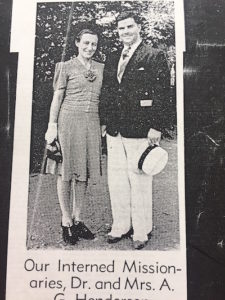

April 1945
Already after only a little more than three months at home [Winnipeg] it is with some difficulty that I recall the impressions made upon me by the experience I have been through during the past four years. Unfortunately, a day to day diary which I had faithfully kept ever since December 1941 had to be left behind in the internment camp at the time of my escape. The healing process of time is remarkable in the way in which it can make us forget the unpleasant happenings and magnify the pleasant ones.
Nevertheless there are certain well-informed pictures which come back to me with crystal clearness. I shall never forget the sense of helplessness which filled my heart when we found ourselves on board the German raider bound for Europe, followed by the successful running of the British blockade which understandably elated the German crew but plunged us into deep despair. Following a six day trip from Bordeaux to Hamburg locked up in a railway compartment we were brutally separated from our wives and forced to march eight miles to a prison camp. Not having been able to take a single step outside the railway coach during the whole of our journey our legs had become swollen due to the lack of protein in our diet and the constant sitting posture. However, our physical sufferings were nothing compared with the mental anguish of not knowing when we would see our wives again.
The above two paragraphs are from Dr. A.G. Henderson, “Out of the Hands of the Enemy,” The Canadian Disciple, April, 1945, Vol. IX, No. 4, Owen Sound, Ontario. On the masthead is written “Published in the Interests of the Churches of Christ in Canada.” Dr. Henderson was my Uncle Fred, the younger brother of my father, Stan Henderson. He and his wife, my Aunt Jamie, were captured by a German warship in April 1941 while they were on the way to the Belgian Congo to be medical missionaries. Aunt Jamie was held prisoner by the German government for about a year, most of which she spent in Berlin. Uncle Fred was held prisoner by the German government in Upper Silesia for almost a year and a half and then transferred in November 1943 to a prison camp north of Belfort, France. He escaped from that camp into Switzerland later that month.
When my sister April, brother Paul, and I were growing up, we often took a copy of the June 2, 1948 Life magazine to school for “show and tell.” It showed my uncle and aunt’s mission in Monieka, Belgian Congo. We had heard part of the story from our father, Uncle Fred’s older brother, but I had no idea of the depth of the story. I got an inkling at a party in Winnipeg that I threw for my father in June 1992. Uncle Fred told me some things I hadn’t heard. So I bought a nice tripod and camera the next summer and went up to Winnipeg to interview Uncle Fred about his experience. (Aunt Jamie had died of cancer in 1987 or 1988.)
In the last few years, I’ve gathered more materials. Two of the books I mentioned a few days ago, about the sinking of the Zamzam. The third, which I read a few years ago, is Carolyn Gossage’s The Accidental Captives: The Story of Seven Women Alone in Nazi Germany. One of those seven women was Aunt Jamie.
In the next few weeks, I’ll post about some of the highlights. This is the first.

READER COMMENTS
Martin Kessler
Aug 1 2018 at 12:48pm
I am at a loss to understand why the Germans treated the Henderson’s and other like people with such deference and care. Please explain. Certainly the transfers and migration were not without cost to the Germans.
David Henderson
Aug 2 2018 at 3:09pm
“with deference and care”
Do you mean rather than murdering them? I don’t understand your point.
Comments are closed.